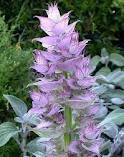Rampion is a flower, a herb and vegetable all rolled into one plant. Its roots look a little like an undernourished mooli or a pale parsnip, and is a root vegetable which can be boiled as you would boil a carrot. However, it is a member of the Campanulaceae family of plants which includes the Harebell (Campanula rotundiflora) to which rampion is a close relative. The stems of both plants contain a milky sap, which was once used as a facial treatment to whiten the skin and free it from blemishes. The distilled water from the plant was also once used for such purposes.
 The rampion was widely used in
The rampion was widely used in These days, the plant is mostly seen as a garden ornamental, as the flowers which are generally lilac, are very attractive and like the harebell. However, the root is quite palatable and a little sweet like a parsnip and the leaves are edible too, so try some if you have it in your borders.
 The Brother’s Grimm featured the rampion in their tale of “Rapunzel” and that name seems to have its origins in the Latin name for the plant, rapunculus, which means little rapa or turnip. One version of Rapunzel tells us that a man and his wife had waited to have a baby for years, so when the woman eventually became pregnant, her husband would do anything for her. They lived near an enchantress who grew rampion in her garden, and the woman began to crave this plant. Her husband dutifully climbed over the wall and got her some one evening, and on subsequent ones, but the enchantress caught him as he was scaling back over the wall. She threatened him with enchantment or death for stealing her rampions and he promised, in return for his life being spared, that he would give her the baby his wife was carrying when it was born. The baby was Rapunzel who was duly handed over to the enchantress. You probably remember the rest of the story so I won’t bore you with it.
The Brother’s Grimm featured the rampion in their tale of “Rapunzel” and that name seems to have its origins in the Latin name for the plant, rapunculus, which means little rapa or turnip. One version of Rapunzel tells us that a man and his wife had waited to have a baby for years, so when the woman eventually became pregnant, her husband would do anything for her. They lived near an enchantress who grew rampion in her garden, and the woman began to crave this plant. Her husband dutifully climbed over the wall and got her some one evening, and on subsequent ones, but the enchantress caught him as he was scaling back over the wall. She threatened him with enchantment or death for stealing her rampions and he promised, in return for his life being spared, that he would give her the baby his wife was carrying when it was born. The baby was Rapunzel who was duly handed over to the enchantress. You probably remember the rest of the story so I won’t bore you with it. There is an old superstition from
There is an old superstition from According to the 16th century herbalist, John Gerard, a decoction of the plant was used to ease sore throats and to soothe inflammations in the mouth. However there is no scientific evidence to support any medicinal uses of rampion.







































